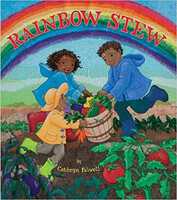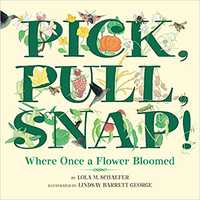Literary
Rainbow Stew

A rainy day in the garden gathering vegetables for the title recipe is the story of this delightful picture book. The fun rhyming words (splish, splash, puddle dash) evoke all the senses and actions while building vocabulary and conceptual understanding. The garden to table process continues with the preparation of Rainbow Stew to the delight of all (Howl! Yowl! Tummies growl), and the charming pictorial demonstration of everyone reading together while the stew cooks is a perfect literacy bonus.
Educator notes:
Informational
Pick, Pull, Snap!: Where a Flower Once Bloomed

This brightly colored book uses accurate botanical drawings to illustrate the progression of flower to fruit, and serves as an introduction to pollination. Text explores the relationship between the various types of pollination - insect, wind and self - and the flower and fruit shapes. This comparison/contrast method puts plant diversity and the interconnectivity of nature in general on cheerful visual display. Educator notes:
Topic: nature, food literacy, botany, gardening,
Age: Primary (K-3)
Active Learning Strategy: Identification Activity
Type: Hands on experiment and identification activity Title: All about Seeds Learning Objectives: The student will:
Description: In this exercise, students will have the opportunity to explore the parts of flowers, fruit and vegetables and to observe and describe the relationship between flower and fruit. A comparison and contrast of flowers will highlight the different types of pollination that exist and enhance the discussion of plant growth and diversity. Materials:
Guided and Independent Practice: Lead discussion involving comparison of flower parts, seeds and fruit and vegetables. Allow children to touch and play with flowers and seeds and talk about how they become fruit and vegetables. This activity also lends itself well to using a K-W-L chart which can be done on a whiteboard or in general discussion. Colored printables, magazine or other colored pictures could be used to create a bulletin board or mural display. Allow the children to discuss and explain what they have seen, how it changes, and what they now know is required to produce individual fruits and vegetables.
Sharing/Reflection/Closing: This activity can be adapted in so many different ways and with different literature texts. As part of a larger curriculum about nature and agricultural literacy, this activity is a wonderfully engaging introduction to seeds and the plant production process. The sensory portion is key, in my opinion, to connect children with actual flowers, seeds and plants, and a garden visit/demonstration would reinforce and enhance the instruction and knowledge retention rate. This activity will also help students practice their observation skills in nature and construct questions based on those observations. Discussion about familiar plants and what their seeds and fruits look like is a great exercise to demonstrate the variety of "fruits" that exist.
|
